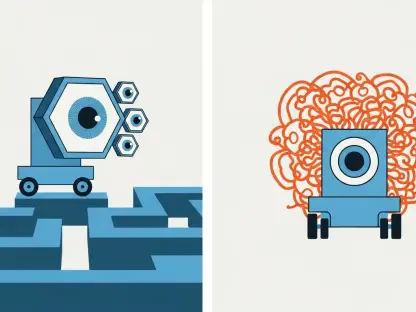The intersection of artificial intelligence and cloud technology has opened new avenues for innovation and efficiency in diverse industries. Microsoft Corporation’s strategic collaboration with Elon Musk’s xAI exemplifies this trend, aiming to enhance its position within the AI domain. Integrating xAI’s Grok 3 model into Microsoft’s Azure AI Foundry reflects a strategic move to fulfill the escalating demand for advanced AI applications. This initiative highlights Microsoft’s strategic maneuvers in leveraging AI advancements within its cloud platform to compete in an industry dominated by prominent tech giants, each seeking primacy in AI-integrated cloud services.
Core Principles and Emergence
AI and cloud integration represent a paradigm shift in technology, poised to redefine how enterprises interact with digital landscapes. This integration combines AI’s ability to process data and learn from patterns with cloud computing’s scalability and accessibility. As businesses increasingly prioritize automation and digital transformation, the pairing of these technologies becomes vital. The trend has gained momentum due to advancements in AI, particularly machine learning, which necessitate substantial computing power and storage. Cloud platforms provide the necessary infrastructure, enabling cost-effective deployment without requiring enterprises to invest heavily in local resources.
Features and Performance Analysis
AI Models within Cloud Infrastructures
AI model integration into cloud environments is transforming how developers and organizations deploy data-driven strategies. Microsoft’s inclusion of xAI’s Grok 3 model demonstrates this integration’s practicality and functionality. By offering this model through Azure AI Foundry, Microsoft amplifies its services’ versatility, providing a broader range of tools for developers. Cloud-hosted AI models facilitate seamless updates, ensuring users have access to the latest features and improvements. The significance lies in lowering entry barriers for adopting sophisticated AI tools, empowering a wide range of industries to innovate and optimize operations.
Spectrum of Cloud-based AI Tools
Cloud-based AI tools and services form a comprehensive ecosystem that supports varied applications, from simple tasks to complex decision-making processes. Microsoft’s AI marketplace, enriched by diverse collaborations, showcases models capable of addressing specific organizational needs. These tools democratize access to cutting-edge AI technologies, enabling businesses of all sizes to leverage AI without the need for extensive technological expertise. The real-world applicability of these tools is evident in their use across sectors, driving efficiency and innovation in industries such as healthcare, finance, and retail.
Innovations and Market Dynamics
Recent innovations in AI and cloud integration are fueling rapid technological advancements. Microsoft’s announcement at the Build 2025 conference emphasized the development of sophisticated AI agents aimed at automating tasks and communications across platforms. The trend of fostering interoperability among AI systems reflects a broader industry shift toward seamless and integrated digital ecosystems. Joint ventures, like the partnership with OpenAI and support for protocols like Anthropic’s Model Context Protocol, illustrate commitments to ethical AI development, promoting responsible usage and standardization across the board.
Practical Applications and Industry Use
AI and cloud integration is already demonstrating substantial impact in real-world scenarios. Microsoft’s collaboration with xAI brings forward AI applications that optimize business processes, enhance customer interactions, and improve decision-making. Industries like autonomous vehicles, healthcare, and finance use AI-powered cloud solutions to analyze large datasets and derive actionable insights efficiently. These applications exemplify unique use cases where technology drives operational excellence and strategic advantages, providing a glimpse into the future potential and scalability of AI integrations.
Navigating Challenges and Constraints
Despite promising advancements, AI and cloud integration face several challenges. Technical obstacles, such as ensuring data security and maintaining infrastructure efficiency, pose significant hurdles. Additionally, regulatory landscapes continue to evolve, necessitating compliance with diverse regional standards. Microsoft’s active pursuit of transparent and ethical AI models addresses concerns highlighted by scenarios like the Grok 3 controversy, asserting the importance of trust and accountability in AI technologies. Ongoing developments aim to alleviate these limitations, paving the way for broader acceptance and implementation.
Future Outlook and Prospective Developments
The trajectory of AI and cloud integration signals promising developments in the coming years. Anticipated breakthroughs in AI capabilities, coupled with ever-expanding cloud infrastructures, suggest potential transformative impacts on multiple industry sectors. Future innovations are expected to enhance integration efficiencies, foster greater interoperability, and promote ethical AI practices. As organizations continue to invest in AI-driven strategies, the synergy between AI and cloud platforms likely will lead to pioneering technological advancements, reshaping how businesses operate and innovate.
Evaluative Summary
This review delved into the transformative possibilities of AI and cloud integration, with Microsoft’s strategic collaboration with xAI as a focal point. Microsoft’s endeavors underscore its commitment to expanding AI offerings and reinforcing its cloud services. The strategic inclusion of models like Grok 3 into Azure exemplifies Microsoft’s calculated approach to capturing the AI market’s potential while promoting ethical standards. As AI continues to advance, its integration into cloud infrastructures remains a critical driver of technological transformation, poised to redefine industry landscapes through strategic partnerships and innovative solutions.









